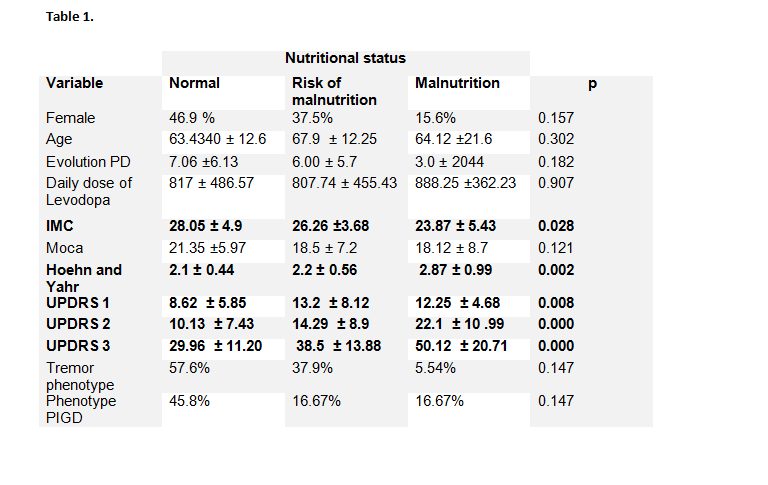Session Information
Date: Tuesday, September 24, 2019
Session Title: Parkinsonisms and Parkinson-Plus
Session Time: 1:45pm-3:15pm
Location: Agora 3 West, Level 3
Objective: To determine the nutritional status in patients with Parkinson’s disease and to relate it to the motor phenotype.
Background: Parkinson disease (PD) is a systemic disease manifesting with cardinal motor symptoms, as well as a series of nonmotor symptoms.1,2 Due to the nature of the disease, it has been reported that people with PD are at a higher risk of malnutrition than others of the same age.3 Influences nutritional status the neuropsychiatric symptoms, pharmaceutical therapy used, and dyskinesias have been found to contribute to decreased food intake, increase energy expenditure, too severity of the disease, and other common non-motor symptoms of PD. 4 The Mini Nutritional Assessment (MNA) is a nutrition screening tool, which determines patient’s nutritional status.5
Method: Transversal descriptive study, 95 patients diagnosed with Parkinson’s disease in different states of Hoehn and Yarh, were evaluated and the motor phenotype was determined through the unified scale of evaluation of Parkinson’s Disease, as well as the severity of the disease, the nutritional status through the MNA, the cognitive status with Cognitive evaluation of Montreal (MOCA). The variables were analyzed with Chi square test, and T test and ANOVA test were used to assess the relationship between motor phenotype and nutritional status.
Results: 55.8% were diagnosed with normal nutritional status, 35.8% were at risk of malnutrition and 8.4 % were malnourished according to MNA. According to the chi-square test, there were no statistically significant results in relation to nutritional status with the motor phenotype with a p-value of 0.147. In the relationship of nutritional status and the stage of Hoehn and Yahr the Chi-square test there was statistical significance with a value of P 0.001 showed a significant increase as the disease progressed. There was no statistically significant difference in relation to nutritional status with age, gender, time of evolution of the disease or the equivalent daily dose of levodopa when analyzing this population. (Table1)
Conclusion: There was no statistically significant difference in relation to the motor phenotype and nutritional status, but there was a relationship between the body mass index and the nutritional status. There was a statistically significant difference between the nutritional status and the clinical stage of Hoehn and Yahr.
References: 1. Chaudhuri, K. R., and Schapira, A. H. (2009).Non-motor symptoms of Parkinson’s disease: dopaminergic pathophysiology and treatment. Lancet Neurol. 8,464–474. 2. Walker RW, Dunn JR, & Gray WK (2011) Self-reported dysphagia and its correlates within a prevalent population of people with Parkinson’s disease. Dysphagia, 26, 92-96. 3. Malnutrition Advisory Group. Guidelines for Detection and Management of Malnutrition. Maidenhead, UK: British Association for Parenteral and Enteral Nutrition (BAPEN); 2000. 4. Sheard, J. M., Ash, S., Silburn, P. A., & Kerr, G. K. (2011). Prevalence of malnutrition in Parkinson’s disease: a systematic review. Nutrition Reviews, 69(9), 520–532. 5. Guigoz Y. The Mini Nutritional Assessment (MNA) review of the literature–What does it tell us? The Journal of Nutrition Health and Aging 2006;10(6):466-85; discussion 485-7
To cite this abstract in AMA style:
R. Cruz, J. Balderas, C. Navarro, L. Zuazua, M. Rodriguez, A. Cervantes. Nutritional status in patients with Parkinson’s disease and its relationship with the motor phenotype. [abstract]. Mov Disord. 2019; 34 (suppl 2). https://www.mdsabstracts.org/abstract/nutritional-status-in-patients-with-parkinsons-disease-and-its-relationship-with-the-motor-phenotype/. Accessed April 2, 2025.« Back to 2019 International Congress
MDS Abstracts - https://www.mdsabstracts.org/abstract/nutritional-status-in-patients-with-parkinsons-disease-and-its-relationship-with-the-motor-phenotype/

